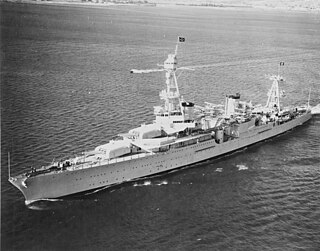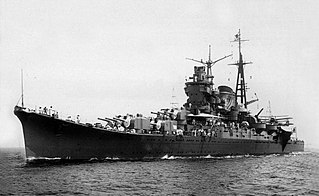
USS Houston (CL/CA-30), was a Northampton-class cruiser of the United States Navy. She was the second Navy ship to bear the name "Houston".

The Battle of the Java Sea was a decisive naval battle of the Pacific campaign of World War II.

USS Baya (SS/AGSS-318), a Balao-class submarine, was a ship of the United States Navy named for the baya. During World War II, she completed five war patrols in the South China Sea, Gulf of Siam, Java Sea, and Philippine Sea between 23 August 1944 and 25 July 1945. She sank four Japanese vessels totaling 8855 gross register tons, and shared credit with the submarine USS Hawkbill (SS-366) for sinking a Japanese 8,407-gross register ton passenger-cargo ship. After World War II, she saw service as a research submarine during the Cold War and operated off Vietnam during the Vietnam War.

The Battle of Sunda Strait was a naval battle which occurred during World War II in the Sunda Strait between the islands of Java, and Sumatra. On the night of 28 February – 1 March 1942, the Australian light cruiser HMAS Perth, American heavy cruiser USS Houston, and Dutch destroyer HNLMS Evertsen faced a major Imperial Japanese Navy (IJN) task force. After a fierce battle lasting several hours, all Allied ships were sunk. Five Japanese ships were sunk, three of them by friendly fire.

Tenryū was the lead ship in the two-ship Tenryū class of light cruisers of the Imperial Japanese Navy. Tenryū was named after the Tenryū River in Nagano and Shizuoka prefectures.

Naka (那珂) was a Sendai-class light cruiser in the Imperial Japanese Navy (IJN), named after the Naka River in the Tochigi and Ibaraki prefectures of eastern Japan. Naka was the third vessel completed in the Sendai class of light cruisers, and like other vessels of her class, she was intended for use as the flagship of a destroyer flotilla.

The four Agano-class cruisers were light cruisers operated by the Imperial Japanese Navy. All were named after Japanese rivers. Larger than previous Japanese light cruisers, the Agano-class vessels were fast, but with little protection, and were under-gunned for their size. They participated in numerous actions throughout World War II.

Noshiro (能代) was an Agano-class cruiser which served with the Imperial Japanese Navy (IJN) during World War II. She was named after the Noshiro River in Akita Prefecture in northern Japan.

Mogami (最上) was the lead ship in the four-vessel Mogami class of heavy cruisers in the Imperial Japanese Navy. She was named after the Mogami River in Tōhoku region of Japan. The Mogami-class ships were constructed as "light cruisers" with five triple 155-millimetre (6.1 in) dual purpose guns. They were exceptionally large for light cruisers, and the barbettes for the main battery were designed for quick refitting with twin 8-inch (203 mm) guns. In 1937 all four ships were "converted" to heavy cruisers in this fashion. Mogami served in numerous combat engagements in World War II, until she was sunk at the Battle of Leyte Gulf in October 1944.

Kumano (熊野) was one of four Mogami class of heavy cruisers in the Imperial Japanese Navy, serving in World War II. She was named after the Kumano River Kii Peninsula on the island of Honshu in central Japan. The Mogami-class ships were constructed as "light cruisers" with five triple 6.1-inch dual purpose guns. They were exceptionally large for light cruisers, and the barbettes for the main battery were designed for quick refitting with twin 8-inch guns. In 1937 all four ships were "converted" to heavy cruisers in this fashion. Kumano served in numerous combat engagements in the Pacific War, until she was eventually sunk by carrier aircraft from Task Force 38 while she was undergoing repairs at Santa Cruz, Zambales, Philippines, in November 1944.

Takeo Takagi was an admiral in the Imperial Japanese Navy during World War II. He was the commander of the IJN 6th Fleet, which oversaw the deployment of all submarines.

Nagara (長良) was the lead ship of her class of light cruiser in the Imperial Japanese Navy. She was named after the Nagara River in the Chūbu region of Japan.

Natori (名取) was a Nagara-class light cruiser in the Imperial Japanese Navy. The ship was named after the Natori River in Miyagi prefecture, Japan. Natori was the third vessel completed in the Nagara class of light cruisers. Like other vessels of her class, she was intended for use as the flagship of a destroyer flotilla.

Maikaze was one of 19 Kagerō-class destroyers built for the Imperial Japanese Navy during the 1930s.

Kako (加古) was the second vessel in the two-vessel Furutaka class of heavy cruisers in the Imperial Japanese Navy. The ship was named after the Kako River in Hyogo prefecture, Japan.

Nowaki was a Kagerō-class destroyer of the Imperial Japanese Navy.

Kishinami was a Yūgumo-class destroyer of the Imperial Japanese Navy.

Jintsū (神通) was the second vessel completed in the three-ship Sendai-class light cruiser in the Imperial Japanese Navy (IJN), named after the Jinzū River in the Gifu and Toyama prefectures of central Japan. She was active in World War II in various campaigns including the Japanese invasion of the Philippines, the Battle of the Java Sea, and Battle of Midway. On 13 July 1943 in the Battle of Kolombangara, she was discovered during a night attack by American ships and sunk in combat.

The Japanese aircraft carrier Taiyō was the lead ship of her class of three escort carriers. She was originally built as Kasuga Maru (春日丸), the last of three Nitta Maru class of passenger-cargo liners built in Japan during the late 1930s for NYK Line. The ship was requisitioned by the Imperial Japanese Navy (IJN) in early 1941 and was converted into an escort carrier. Taiyō was initially used to transport aircraft to distant air bases and for training, but was later used to escort convoys of merchant ships between Japan and Singapore. The ship was torpedoed twice by American submarines with negligible to moderate damage before she was sunk in mid-1944 with heavy loss of life.

The Japanese destroyer Asakaze was one of nine Kamikaze-class destroyers built for the Imperial Japanese Navy (IJN) during the 1920s. During the Pacific War, she participated in the Philippines Campaign in December 1941 and the Dutch East Indies Campaign in early 1942. She took part in the Battle of Sunda Strait in March and helped to sink two Allied cruisers. She was sunk by USS Haddo in August 1944.























